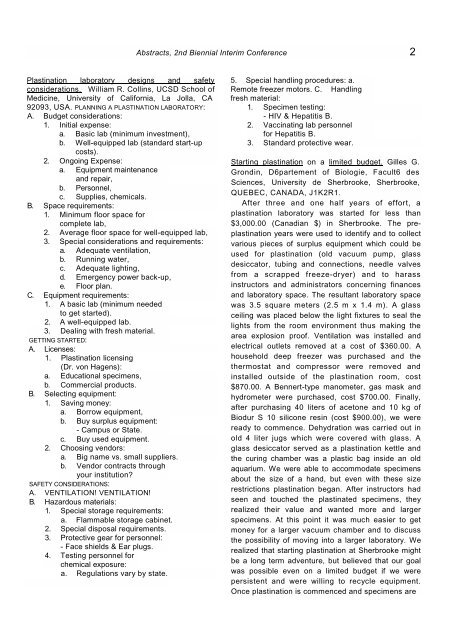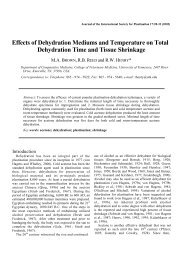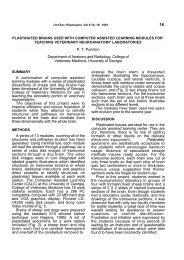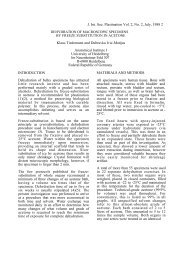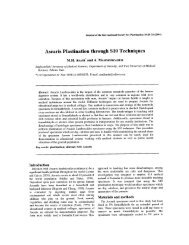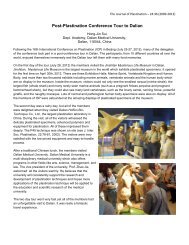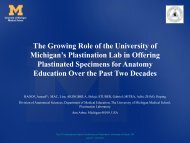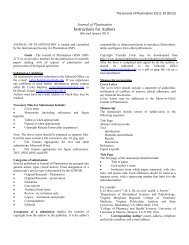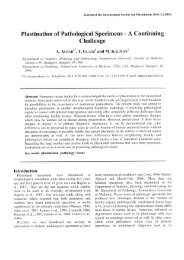a. ventilation! - Journal of Plastination
a. ventilation! - Journal of Plastination
a. ventilation! - Journal of Plastination
Create successful ePaper yourself
Turn your PDF publications into a flip-book with our unique Google optimized e-Paper software.
3 J Int Soc <strong>Plastination</strong>, Vol 6, 1992Starting <strong>Plastination</strong> on a Limited Budget1.4 m.produced, you can easily demonstrate its worth andimprove your laboratory."Forced air" impregnation <strong>of</strong> air-dried lungs - Arecent development in <strong>Plastination</strong> producing life-likelung specimens. Robert W. Henry, College <strong>of</strong>Veterinary Medicine, The University <strong>of</strong> Tennessee,Knoxville, TN, USA.Air-dried lungs at room temperature wereimpregnated with a mixture <strong>of</strong> S10/S3 (polymer-mix)and xylene. Compressed air from the laboratorybench was used to propel the polymer-xylene mixfrom the air ways into the parenchyma <strong>of</strong> the lungtissue and on through to the surface <strong>of</strong> the lung.The lungs were dried using air from the laboratory airsupply line. Mixtures <strong>of</strong> xylene and S10/S3, whichvaried from 15% to 45%, were forced into lungs, toimpregnate the lungs with silicone, via forced airrather than using dehydration and vacuum. Thetrachea was cannulated and the lungs positionedsuch that one-half <strong>of</strong> the polymer-xylene mix waspoured into the left portion <strong>of</strong> the airway and theother half <strong>of</strong> the mix into the right portion <strong>of</strong> theairway. Laboratory air (dried medical air), at a highvelocity and pressure (30 - 50 Ibs/sq. in.), was
5 J Int Soc <strong>Plastination</strong>, Vol 6, 1992will keep the specimens submerged. The specimensare allowed to stand in the polymer mix over nightand hence equilibrate with the polymer. The vacuumis increased gradually over a period <strong>of</strong> 3 - 5 weeksuntil nearly total vacuum (one atmosphere) has beenreached. This gradual increase in vacuum allows theintermediary solvent which has a lower boiling point(acetone: +56°C and methylene chloride: +40°C),than that <strong>of</strong> the polymer mix, to be extracted fromthe specimen and evacuated through the exhaustsystem <strong>of</strong> the pump. The loss <strong>of</strong> the intermediarysolvent from the tissue results in a pressuredifference between the interstitium <strong>of</strong> the specimensand the polymer mix allowing the polymer to bedrawn into the tissue. The extraction <strong>of</strong> the volatileintermedium (boiling) must be slow enough to allowsufficient time for the polymer to enter the specimen.Extraction <strong>of</strong> intermedium is monitored by observingbubble formation on the surface <strong>of</strong> the polymer mix.When boiling is too fast, the polymer does not haveenough time to flow to all parts <strong>of</strong> the specimen.This may allow the structural framework <strong>of</strong> the tissueto collapse and the specimen may shrink. Vacuum iscontrolled by an air inlet valve and pumping speed.<strong>Plastination</strong> - Gas curing (hardening). Robert W.Henry, College <strong>of</strong> Veterinary Medicine, The University<strong>of</strong> Tennessee, Knoxville, TN, USA.Curing or hardening <strong>of</strong> the polymer varies for eachpolymer used. Curing for the standard siliconeprocedure will be discussed. After impregnation <strong>of</strong>the specimen with polymer, the polymer must behardened. Curing takes place on the surface <strong>of</strong> thespecimens first and then progresses to the interior <strong>of</strong>the specimen. For the S10 process, Biodur Gas Cure(S6) is the hardening agent. S6 begins the process<strong>of</strong> side-to-side linkage <strong>of</strong> the polymer molecules. Sideto-sidelinkage produces a stronger product.Basically, the S6 vaporizes and reacts with thepolymer. Two curing procedures have evolved overthe years: Slow cure - in which the specimen isallowed to remain at room temperature for severalweeks prior to exposure to S6. This enhances moreS3 activity and hence more end-to-end linkage and amore flexible specimen. Exposure to heat may alsobe used with this methodology. The other procedureis: Fast cure - whereby the impregnated specimen isexposed to a concentration <strong>of</strong> S6. Volatilization maybe enhanced by bubbling air through the S6. Theenvironment for the fast cure should be dehumidifiedvia a desiccant (calcium chloride). An increase inhumidity may cause white silicate salt precipitationson the surface <strong>of</strong> the specimen. A hollow organ mayhave a concentration <strong>of</strong> volatilized S6 directed intoits lumen to assure that the organ remains dilatedand hence in a dilated position after the polymer ishardened. Both the slow and fast cure method utilizeBiodur S6 and exposure to S6 is carried out in aclosed chamber at room temperature. Once thespecimen is exposed to S6, the surface <strong>of</strong> thespecimen is hardened after 12 to 36 hours.However, the interior <strong>of</strong> the specimen will take longerto harden and is dependent on the S6 penetrating tothe depths <strong>of</strong> the specimen. Yet the specimen maybe used before curing is completed to its depths.After curing is complete, the specimen can be storedindefinitely at room temperature.Plastinated specimens, an aid to understandingstandard imaging planes for two-dimensional, realtimeecho cardiography m the dog. Robert W. Henryand Janice M. Bright, Department <strong>of</strong> Animal Science,College <strong>of</strong> Veterinary Medicine, University <strong>of</strong>Tennessee, Knoxville, TN 37901 USA.Ultrasonography is a valuable method forevaluating structure and function <strong>of</strong> the heart. Twodimensional,real-time echocardiography (2DE)provides images in a single plane, and standardimaging planes have been described for evaluation <strong>of</strong>the canine heart. Single frame images from thesestandard imaging planes were obtained from realtime,2DE examination <strong>of</strong> healthy dogs. The imagesare presented with plastinated specimens which weresectioned along corresponding imaging planes inorder to illustrate three dimensional anatomy relativeto the two dimensional sector. In addition, labelledphotographs <strong>of</strong> the sectioned specimens aredisplayed adjacent to the echocardiographic images.Standard imaging planes are designated andtransducer positions, used to obtain standard imagingplanes, are described. To enhance the student'sability to interpret standard imaging planes, a cadaverheart was prepared for plastination by separation <strong>of</strong>the lungs from the heart and transecting thepulmonary vessels as long as possible. The caudalvena cava and a pulmonary vein were cannulatedwith an appropriate size <strong>of</strong> tubing and the heart wasflushed to remove blood with warm tap waterthrough both cannulas. The other large vessels wereclosed by ligating a bleached cork in place (larger endinto vessel). The remaining smaller vessels were
Abstracts, 2nd Biennial Interim Conference 6closed with suture or hemostatic clips. The heartwas hydrostatically dilated with cold water, dilatedfixedwith a 5% Kaiserling's solution, dehydrated incold (-25 °C) acetone, and impregnated with BiodurS10-S3 polymer-mixture. Following impregnation,the heart was drained <strong>of</strong> the excess polymer-mix andexposed to Biodur S6 (gas curing agent). Duringcuring, the heart was manicured daily to removeexcess polymer-mix which accumulated on thesurface <strong>of</strong> the specimens. After curing the heart wassectioned along the planes <strong>of</strong> standard images.A new perspective jn teaching human anatomy.Alexander Lane, Triton College and University <strong>of</strong>Illinois at Chicago, Chicago, IL, USA.Currently, my research involves a comparisonbetween mathematically computed clinical sections<strong>of</strong> the human body and sheet plastinated cadaversections. Computers are making a tremendousimpact on the teaching <strong>of</strong> human anatomy anddiagnostic medicine. For instance, as a result <strong>of</strong> thecomputer imaging devices, more progress has beenmade in diagnostic medicine in the past 15 yearsthan in the entire previous history <strong>of</strong> medicine. Thereare five major computer body scanning systems.This research is confined to three <strong>of</strong> these modalities.Comparisons are made between scans fromultrasound (sonography), magnetic resonanceimaging (MR) and computed tomography (CT). All <strong>of</strong>these systems present the body in thin slices withoutsurgery for study and diagnosis.Sheet plastinated cadaver sections are suitable fora comparison with computer scans because <strong>of</strong> thesimilarities in thickness. The purpose <strong>of</strong> this study isto add a new perspective to the usual methods andapproaches in teaching Human Anatomy. This newperspective is needed in order to update teachingmethodology and meet the need to properly identifyand interpret structures seen on modern computerbody scans. Similarities and differences are stressedto demonstrate comparison and correlation betweencadaver sections and computed clinical images. Thecadaver sections provide a standard and a means <strong>of</strong>demonstrating the limitations <strong>of</strong> the imagingmodalities. Further, the cadaver section providesconfirmation that the slice one gets using an imagingdevice is a true representation <strong>of</strong> that area <strong>of</strong> thebody.In this new perspective, structures <strong>of</strong> eachcadaver or clinical section are classified into fouranatomical categories (Lane, 1990). Thismethodology not only enhances learning but alsohelps to differentiate the quality <strong>of</strong> the resolution byimaging devices <strong>of</strong> various anatomical structures.For example, some imaging devices depict thevisceral structures with high resolution butmusculoskeletai unit structures are shown poorly bythe same device.LANE, Alexander: Sectional anatomy: Standardizedmethodology, J Int Soc <strong>Plastination</strong> 4:16-22, 1990.High purity solvent recycling <strong>of</strong> acetone in the<strong>Plastination</strong> laboratory. Roger R. Roark, Jr., V. P.,B/R Instrument Corporation, Easton, MD, 21601,USA.The recovery <strong>of</strong> high purity acetone from<strong>Plastination</strong> techniques has become an interestingtopic due to strict regulations promulgated by the U.S. Congress and enforced by the U. S. EnvironmentalProtection Agency. Recycling acetone saves thelaboratory money by reducing the purchase <strong>of</strong> thefresh solvent and the disposal cost <strong>of</strong> the hazardouswaste.For any solvent recycling operation to besuccessful, the first priority must be solvent qualitythat is equal to or better than the original purchased.Acetone with large amounts <strong>of</strong> water and othercontaminants are generated in the plastinationprocess. The recycling system must have adistillation system with sufficient theoretical plates toachieve the separation. B/R Instrument hasdetermined that at least ten plates are necessary fora good acetone-water separation. Twenty to thirtytheoretical plate spinning band columns have beenshown to recycle a 50:50 acetone-water mix to99% + pure acetone. The formation <strong>of</strong> paraformaldehyde from formalin contamination is aproblem. Further research in this area is needed.Economic and environmental concerns have madehigh purity solvent recycling and attractive alternativeto solvent purchase and disposal. Like otherlaboratories generating waste, the plastinationlaboratory must strongly consider this option.Sheet plastination <strong>of</strong> the brain, P 35 technique, fillingtechnique. Wolfgang Weber, Department <strong>of</strong>Veterinary Anatomy, Iowa State University, Ames,Iowa 50011, USA.Sheet plastinated specimens have the highestacceptance <strong>of</strong> preserved body slices. Since thedevelopment <strong>of</strong> the P 35 technique, cross sections <strong>of</strong>
7 J Int Soc <strong>Plastination</strong>, Vol 6, 1992the brain never were as detailed even when stained,never were as durable, and never were as easy tohandle. There are two techniques for sheetplastination. Brain sheets are done with a polyestercompound,BIODUR P 35. While, cross sections <strong>of</strong>the body are done with an epoxy compound, BIODURE 12. The procedures are similar, but for the sake <strong>of</strong>clarity, each procedure will be described in a separatearticle.LIST OF NECESSARY EQUIPMENT:A Vacuum chamber; Manometer; BiodurPolymers: P 35 and A 9, Biodur cobalt accelerator(PB 11), Meat slicer; 2 UVA-lamps, 45°C oven.Stainless steel or aluminum grids; Grid basket (HD 09or HD 10); Square buckets or appropriate containersfor storage and dehydration <strong>of</strong> specimens. Toassemble each flat chamber: 2 Tempered glass plates(5mm) (HS 01), 2 Thin glass plates (1-2mm) (HS03), 6mm Gasket (HS 06), 4 small (HS 32) and 15large (HS 30) Fold back clamps or 2 inch binderclamps, Plastic sleeve or hose (to serve as a funnel),and Pressure sensitive tape.FIXATION OF BRAIN: 10-20% formalin solution.SLICING THE BRAIN: Flush in tap water. Divide braininto two pieces, return one portion to the water andlay a wet filter paper on the cut surface <strong>of</strong> the otherportion to keep the specimen moist and serve as asupport for the slice. Meat slicer at 4mm. Place ona stainless steel grid (filter paper side down).FLUSH THE BRAIN SLICES: 4 hours via tap water.COOL IN DEIONIZED WATER: Store overnight at (5°C) inthe deionized water.FREEZE SUBSTITUTION: Submerge in - 20°C cold 100%acetone. One acetone bath <strong>of</strong> adequate fluid/tissueratio is sufficient for brain slices.IMMERSION INTO POLYMER: Polymer mixture <strong>of</strong> P 35(resin) arid A 9 (hardener), a ratio <strong>of</strong> 100:2 and keepin the dark. Immersion 1: After 48 to 96 hours <strong>of</strong>freeze substitution, transfer to cold polymer mixture.Immersion 2: After 24 hours, transfer specimens intoa new polymer mix (100:2) for 24 hours.IMPREGNATION: New reaction mixture <strong>of</strong> P 35(polymer) and A 9 (hardener) (100:2 ratio) anddeaerate. Room temperature, in the dark, and for 21hours. Increase the vacuum hourly and stabilize at20mm Hg and leave over night. Do not evacuatebelow 12mm <strong>of</strong> Hg.PREPARATION OF "DOUBLE GLASS PLATES": Temperedglass plates <strong>of</strong> 5mm and 1-2mm (window glass)thickness are combined to form one side <strong>of</strong> the flatchamber. Tape the top edge, place fold back clampson bottom edge.CASTING: Place 6mm gasket on a "double glass plate"and remove the clamps. Place brain slice on glass.Place second double glass plate, thin glass towardspecimen, on specimen. Align gasket and place foldback clamps along edge.FILLING THE MOLD: Stand mold upright (taped side up),insert plastic sleeve and fill chamber with freshpolymer mix (P 35/A 9). (100:2) (600 cc). Allowtrapped air bubbles to rise by spreading the doubleglass plates and storing for 30 minutes in dark (toprevent early curing <strong>of</strong> the sheet)CURING: Initiate with UV-light, complete in a 45°Coven. Light Curing: Light source applied to bothsides for 45 minutes. Heat Curing: Place in 45 "Coven for 5 days.DISMANTLING: Remove from oven in 5 days. Cool toroom temperature.TRIMMING: Table, radial, or band saw. Smooth edges- belt sander.CLEANING THE GLASSdishwasher at 85°C.DISPOSAL OF OLD POLYMER:Cobalt promoter (0.5%).PLATES: Detergent in aHarden polymer with3rd Biennial Interim Conference on<strong>Plastination</strong> University <strong>of</strong> SouthAlabama Mobile, Alabama, USAAugust 5, 6 and 7, 1993Beautiful white sand beacheson the Gulf <strong>of</strong> Mexico.Plan now to attend!!


